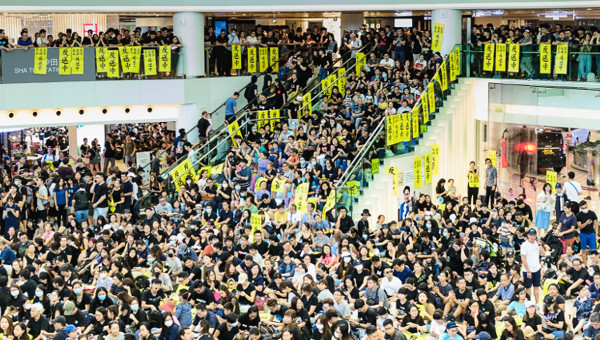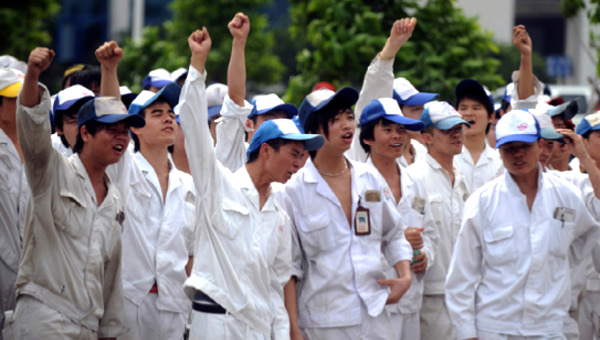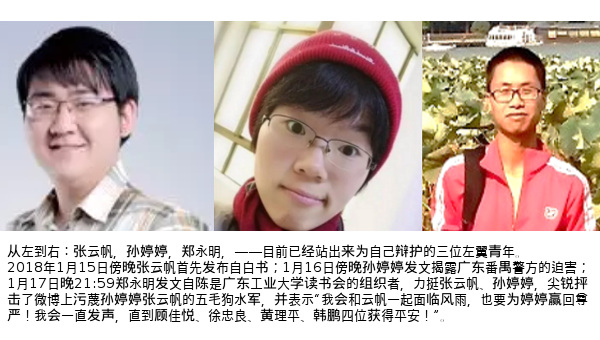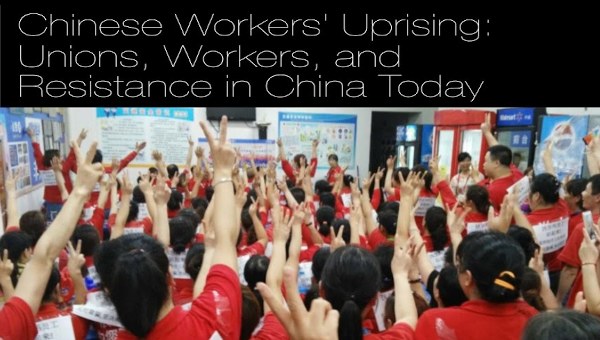The largest student demonstrations and occupations in Hong Kong’s history is currently unfurling – what is increasingly being called the “Umbrella Revolution” in reference to the sea of umbrellas being used as cover against both pepper-spraying riot police and the rays of the sun (the latter a common practice in Northeast Asia). What began as a Hong Kong-wide class boycott on Monday September 22 with around 10,000 university and college students congregating on the Chinese University of Hong Kong campus for speeches and volunteer lectures on civil disobedience – moving across town to a sit-in on Wednesday the 24th in front of the main Hong Kong government buildings in the district of Admiralty – by the night of Monday September 29 morphed into an unprecedented occupation of four major districts in Hong Kong involving at least 80,000 people, predominantly students. Three major arteries running through Admiralty, Central, and parts of Wan Chai (a roughly 2.5km by 500 meter area) – constituting the core business and government skyscrapers in Hong Kong, and encompassing the headquarters of the 6,000-strong People’s Liberation Army (PLA) of China Hong Kong garrison – in addition to the largest intersection in Causeway Bay (Hong Kong’s busiest shopping neighborhood) and the main thoroughfare in Mong Kok and Jordan (Nathan Road) across the harbor in Kowloon (one of the most densely populated districts in the world), are in complete lock-down with multiple barricades and throngs of students blocking all traffic.
Students, Umbrellas and Occupiers
 This stunning accomplishment that has shocked everyone (including the students themselves) follows violent police repression on Saturday and Sunday of an intensity not seen on the streets of Hong Kong since 1967, when the Chinese Communist Party (CCP) tried to spread the Great Proletarian Cultural Revolution (GPCR) to the then-British colony. The main organizer of the week-long boycott of classes, the Hong Kong Federation of Students (HKFS), had planned on ending the strike and sit-in in front of the government buildings on Friday evening, but late that night some 200 or so students stormed a police line and fence to occupy a square within the government complex. The police reacted violently with batons and pepper spray, making over 70 arrests, including one of the most high profile student leaders, 17 year-old Joshua Wong, co-founder of the mostly high school student group Scholarism. As news of the violent police repression swiftly spread, masses of students and other supporters poured into the whole area, eventually blocking major roads (on Monday afternoon there were still some abandoned BMWs and public buses in the middle of the road surrounded by throngs of students).
This stunning accomplishment that has shocked everyone (including the students themselves) follows violent police repression on Saturday and Sunday of an intensity not seen on the streets of Hong Kong since 1967, when the Chinese Communist Party (CCP) tried to spread the Great Proletarian Cultural Revolution (GPCR) to the then-British colony. The main organizer of the week-long boycott of classes, the Hong Kong Federation of Students (HKFS), had planned on ending the strike and sit-in in front of the government buildings on Friday evening, but late that night some 200 or so students stormed a police line and fence to occupy a square within the government complex. The police reacted violently with batons and pepper spray, making over 70 arrests, including one of the most high profile student leaders, 17 year-old Joshua Wong, co-founder of the mostly high school student group Scholarism. As news of the violent police repression swiftly spread, masses of students and other supporters poured into the whole area, eventually blocking major roads (on Monday afternoon there were still some abandoned BMWs and public buses in the middle of the road surrounded by throngs of students).
On Saturday, the three co-founders of the group Occupy Central with Love and Peace announced the commencement of Occupy Central, moved forward from its initial start-date of Wednesday October 1 (a public holiday in China, including Hong Kong, commemorating the 65th anniversary of the founding of the People’s Republic). Two professors and a clergyman initiated plans in January 2013 to occupy what is now a comparatively tiny section of Central, the downtown core of Hong Kong. Some students accused the co-founders of Occupy Central of opportunism and hijacking the student-initiated mass sit-in, but others welcomed the extra support. By Monday the three co-founders moved out of the main government building area, with at least one moving to the occupation in Kowloon across the harbor – hence the epicenter of Admiralty remains almost entirely student-driven.
On Monday scores of businesses could not open due to being in the occupied zones, and over 200 public transportation lines were either cancelled or heavily diverted, the former including the iconic double-decker trams. According to the Hong Kong Monetary Authority (the territory’s de facto central bank), “23 banks including HSBC and Standard Chartered had closed a total of 44 branches, offices and cash machines.” Both the Hong Kong dollar and the Hang Seng stock index fell on Monday morning. Hong Kong air and noise pollution plummeted from the absence of traffic, with eerie scenes of major thoroughfares several blocks from the epicenter being virtually empty on Monday afternoon (before being filled again with students and supporters by Monday evening). The City Hall was forced to shut down for the first time since Typhoon Wanda in 1962.
Screw Us and We Multiply
In the aftermath of Sunday’s violent police repression of peaceful and unarmed students (many of them teenagers) – according to the police themselves firing tear gas 87 times in nine separate areas – support has been broadening and deepening, with thousands more on the streets from the after-work crowd on Monday and Tuesday. The Confederation of Trade Unions and the Professional Teachers Union both called on its members to strike in support of the students. At least 1,000 social workers, high school and university teachers joined the strike, as well as pupils from at least 31 schools. HKFS extended the student class boycott indefinitely. The Chairperson of Swire Beverages Employees General Union, distributor of Coca Cola in Hong Kong, announced to cheering students in Admiralty that more than 200 workers joined the strike, while 100 more reduced their hours. There were also reports of some taxi drivers striking. Even certain chief executives supported the strike, with for example CEO Spencer Wong of the McCann advertising firm informing employees: “It’s up to you whether you come to work of [sic] not. The company will not punish anyone who supports something more important than work.” This is a sharp turnaround from July when the Big Four global accounting firms published a joint warning against Occupy Central of impending chaos if they had their way. A number of legislators, especially from the Civic and Democratic Parties, have also expressed support, with some even being arrested on Saturday and Sunday.
But the vast majority of the initiative, leadership, and involvement remains with the students, many of them protesting for the first time. There is a constant stream of supplies pouring into the occupied zones, from water bottles to sodium chloride (first-aid against tear gas) and surgical masks to food and sleeping mats. Support and donations arrive from all walks of life and ages, from a pre-teen helping with cleanup to a 92 year-old lady chanting on the frontlines. There is no centralized chain of command, with the occupations now far beyond the control of either the leadership of the HKFS or Occupy Central with Peace and Love, with many spontaneous actions sprouting across the occupied zones (such as small groups bringing large objects from afar to construct more and increasingly elaborate barricades along the streets). Perhaps most significantly, even more students poured onto the streets after the leadership of HKFS and Occupy Central on Sunday night urged students to return home, as rumors swirled of the impending use of rubber bullets by riot police and increasing fears of a Tiananmen Square-like crack-down in which at least 2,600 students were massacred in 1989 (while many riot police brandished military-style rifles before being taken off the streets by Monday afternoon, thankfully none were used).
The core demand is for universal suffrage to decide Hong Kong’s Chief Executive Officer (what is essentially its mayor), rather than the changes proposed by Beijing on August 29th that would render it impossible for any anti-CCP candidate to run for office. From Monday morning, another demand being increasingly shouted is for the current Chief Executive C.Y. Leung to step down, and initiate a new reform proposal committee.
What is clear is that the ramped up police repression on Sunday failed spectacularly, echoing a sign popular in Madison, Wisconsin in spring 2011: “Screw us and we multiply.” There was widespread outrage over the violent police tactics on unarmed, overwhelmingly peaceful and non-aggressive students, many of them simply quietly sitting around. Yet, as mentioned above, the police fired tear gas 87 times in nine separate areas, according to their own estimate. Incidentally, the stockpile and use of tear gas is banned by the 1993 UN Chemical Weapons Convention, of which China is a signatory. Apart from using tear gas against South Korean farmers during the 2005 WTO protests, the streets of Hong Kong have not seen this chemical weapon since 1967.
 The riot police were formally taken off the streets by noon Monday, officially because the “illegal protesters” have “mostly calmed down.” In reality, the riot police were the ones that calmed down once they realized they could not defeat the students. During the climax of repression on Sunday night, I was in one area that was tear gassed around 4-5 times (each barrage with multiple canisters) in only two hours. The police formed two lines and fired tear gas in order to advance toward the epicenter in Admiralty, after which most of the crowd would flee and then quickly regroup, surrounding the police on both sides with hands in the air to show non-violent intent.
The riot police were formally taken off the streets by noon Monday, officially because the “illegal protesters” have “mostly calmed down.” In reality, the riot police were the ones that calmed down once they realized they could not defeat the students. During the climax of repression on Sunday night, I was in one area that was tear gassed around 4-5 times (each barrage with multiple canisters) in only two hours. The police formed two lines and fired tear gas in order to advance toward the epicenter in Admiralty, after which most of the crowd would flee and then quickly regroup, surrounding the police on both sides with hands in the air to show non-violent intent.
On another note, while unprecedented for Hong Kong, the violent police repression was still relatively tame compared to the demeanor, equipment, and tactics now often employed by the heavily militarized police in North America, from the 2010 Toronto G20 protests to Ferguson, Missouri last month. By Monday afternoon, there was only a heavy police presence around the government buildings, the PLA HQ, and the police HQ (all within a few blocks of each other). Vast areas had no police presence at all, of which many students took ample advantage, extending the barricades several hundred meters to the five-star Mandarin Oriental Hotel in the west, into the heart of the poshest shopping district of flagship luxury brands (a significant advancement of occupied territory from Sunday night).
The expanding Umbrella Revolution is no doubt a momentous conjuncture for Hong Kong, and possibly for China itself. All local news outlets are of course doing live and ongoing coverage, but this has also received much international attention. The New York Times, Financial Times, Wall Street Journal, and others have their Asia headquarters in Hong Kong, and all have given this their front page. There also happen to be a number of veteran China reporters that have been deported from the Mainland in the past year or two (especially from Bloomberg and the New York Times), and most have relocated to Hong Kong – from where they are all too happy to write less than enthusiastically on the CCP and the heavy-handed and disproportionate repression of the Hong Kong police. A common chant heard on the streets is “the world is watching.”
Nothing short of the future of Hong Kong is at stake. Officially, Deng Xiaoping’s promise of “one country, two systems” is supposed to last until 2047 (half a century after the 1997 handover), but many in Hong Kong fear that Beijing is gradually moving toward “one country” much sooner. The CCP’s attempt to change the security law in 2003 and standardize the education system to emphasize “love of China” in 2012 were both defeated due to hundreds of thousands taking to the streets. The latter incident is the context in which Joshua Wong, then 14 years old, co-founded Scholarism to protest Beijing’s attempted interference in Hong Kong’s school curriculum.
But this time is different. We are currently in the midst of by far Hong Kong’s largest civil disobedience ever. Students have pledged to maintain the occupied zones, vastly larger than Occupy Wall Street or any of its global spawns ever were, until Beijing reneges on its August 29th proposal and grants Hong Kong universal suffrage. Students are so far incredibly successful, unimaginably more than anyone could have predicted even on Sunday morning. Perhaps most importantly, momentum is far greater on the side of the students, as we begin two Chinese public holidays (including in Hong Kong), tomorrow and Thursday. Whatever the eventual outcome, at the very minimum the Umbrella Revolution will have politicized a new generation of Hong Kongers. Of course, this doesn’t mean everyone will be radicalized, as for example numerous veterans of 1989 Tiananmen Square after being exiled to the West became investment bankers or Silicon Valley capitalists. Nevertheless, others became critical scholars or full-time activists, perhaps most prominently Han Dongfang, the number one most wanted man by the CCP in the aftermath of June 4, 1989, who gave himself up and was tortured for 22 months in a Chinese prison, and subsequently exiled to Hong Kong where in 1994 he founded China Labour Bulletin, which is still going strong today.
Students and Workers Stand up, Fight Back
Moreover, by far the largest act of civil disobedience in Hong Kong history comes at a very awkward time for the Chinese Communist Party, which at least partly explains the unprecedented and swift but spectacularly failed attempt by the Hong Kong Police to violently repress the students and prevent their momentum from growing. With President Xi Jinping’s “anti-corruption campaign” so far targeting only his rival factions, the CCP is currently in the midst of the one of the most serious tests to its unity in decades. More broadly vis-à-vis the Chinese people, the CCP is increasingly using nationalism and China’s “glorious” past, including reviving Confucianism, once reviled by the CCP as a product of feudal and patriarchal authoritarianism, in order to replace “communist” ideology. Indeed, the CCP announced that class struggle was officially over in China, and therefore removed the right to strike from the constitution in 1982. Yet, since especially the Nanhai Honda strike in 2010, there have been hundreds if not thousands of increasingly daring strikes across China, the largest of which was earlier this year when 40,000 workers at a Dongguan shoe factory went on strike, less than 100km north of Hong Kong. And certainly after 1989, it is clear that the tenets of freedom of assembly and speech do not jive well with this CCP hegemonic project, yet are very dear to the hearts of many Hong Kongers. At the time of the handover, Hong Kong’s GDP accounted for almost a fifth of China’s, yet today it is only 3 per cent. The central government in Beijing will likely do much in its now considerable imbalance of power to prevent any demonstration effect in Hong Kong that might spread to the Mainland. And there is certainly the basis for an Occupy Shenzhen and others across China, as many grievances range from high labour exploitation to severe air pollution, from food safety scandals to rural and urban land seizures, from widespread corruption to increasing violent crime and one of the highest inequality rates in the world.
Hence, especially over the past ten years, burgeoning social unrest in China seems to be increasingly rattling the upper echelons of the CCP. Since 2009 China spends more on domestic security than external military defense. And the CCP has reacted to the Umbrella Revolution with record Internet censorship on the Mainland, banning many search words such as “Class boycott,” “Occupy Central,” “Hong Kong police,” and “Hong Kong tear gas,” while deleting relevant posts on Weibo, China’s Twitter-like social network, including all posts with the hashtag #HongKong. Meanwhile, for the first time, China completely blocked Instagram on Sunday morning, as pictures from Hong Kong started to go viral around the Mainland. There is already contagion internationally, as hundreds of supporters in Taiwan (a country with its own misgivings concerning Beijing’s increasing encroachment, as witnessed by its “Sunflower movement” earlier this year when students occupied the Taiwanese parliament) occupied the lobby of the Hong Kong Trade Office. Solidarity demonstrations are also planned across the world over the next couple days, from Paris to Sydney, from San Francisco to Vancouver and Toronto. China, of course, has a massive diaspora abroad, much of which is still deeply connected with the Mainland (as well as Hong Kong).
But back in “Asia’s world city,” Beijing is in a real damned if they do, damned if they don’t situation. Granting universal suffrage to Hong Kong would be a significant setback for the authority of the CCP, with highly uncertain consequences both in Hong Kong and the Mainland concerning the CCP’s paramount goal: the longevity of its power. But at least at the time of writing, tens of thousands of students and their supporters remain more entrenched in the three main occupied zones than on Sunday. Seventeen year-old Joshua Wong of Scholarism has said that most do not expect Beijing to back down, but that was last week. Similarly, many a week ago expected Occupy Central to fail in occupying only a tiny square in Central; even the co-founders did not dare to dream of maintaining a complete lock-down of vast swathes of Hong Kong spanning three of its most important neighborhoods.
As of Tuesday night Hong Kong time, the possibility of what would be an historic retreat by the Chinese Communist Party with unknown consequences is at least slightly higher than it was only a few days ago. And very few seriously give any likelihood to a bloodbath on the scale of the Tiananmen Square massacre. There would simply be too big a risk that Hong Kong would be rendered utterly ungovernable if such a tragedy occurred. Beijing also signaled on Sunday that it would not intervene, and praised the Hong Kong police for handling the situation well. That was, however, before the massive student success and advancements on Monday that have continued into Tuesday. If the student-led occupations cannot be defeated soon, each day that goes by increases the risks for Beijing of contagion. In the immediate short-term, the students have this Wednesday and Thursday on their side, as both are public holidays in China, including Hong Kong. The annual fireworks celebrating the coming to power of the CCP on October 1, 1949, usually scheduled for tomorrow has been cancelled by the Hong Kong government. An average 800,000 Mainlanders cross the border into Hong Kong every day, and this will see a sizable increase tomorrow and Thursday due to the national holidays.
One problem, however, is that the vast majority of students have very little political experience, let alone an awareness of the incompatibility of capitalism and democracy, not to mention the environment. Some make the connection between increasing inequality in Hong Kong, with universal suffrage as a means to counter the power of tycoons, the majority of whom are pro-Beijing and of course favour the status quo. But I have argued in an opinion piece that will be published by Hong Kong’s main English-language newspaper, the South China Morning Post, that too few discuss whether political democracy is possible without economic democracy. Regardless, this is certainly a giant first step in politicizing a new generation of Hong Kongers, a populace more known for shopping in gleaming malls rather than occupying vast swathes of the third most important financial center in the world. Also, from my own very limited one-month experience so far teaching at City University of Hong Kong, many students are extraordinarily receptive to criticism of capitalism at large, more so than my former students at York University in Toronto.
The Umbrella Revolution and the Global Cycle of Protest
 As should be clear, the Umbrella Revolution is shaped by specific local conditions in Hong Kong. With that said, it must be placed in the broader context of occupations and popular uprisings the world over that have been inspired by the Arab Spring, especially the occupation of Tahrir Square in early 2011. The occupation of Tahrir Square inspired the occupation of the State Capitol building in Madison, Wisconsin and the indignados of Madrid, Spain – both of which inspired Occupy Wall Street in September 2011 and the subsequent blossoming of Occupies around the world, including the original Occupy Central, one of the longest-lasting camps, until September 2012. And as the Umbrella Revolution and other recent protests around the world reveal, the conditions continue to be ripe for politicizing the masses of especially young people for the first time (as well as occasionally breathing fresh air into the spirits of 1968 Paris and 1999 Seattle veterans, among others). The ranks of those receptive to radical system change around the world continues to swell as the twenty-first century progresses, even if some also drop out and/or need greater encouragement. In any case, in regard to the largest civil disobedience ever in Hong Kong, anyone’s crystal ball as to how this will end is as uncertain as anyone else’s. What is certain, however, is that the humble umbrella will forever have a new significance in Hong Kong: to protect not only from rain and shine, but also from the instruments of state repression. •
As should be clear, the Umbrella Revolution is shaped by specific local conditions in Hong Kong. With that said, it must be placed in the broader context of occupations and popular uprisings the world over that have been inspired by the Arab Spring, especially the occupation of Tahrir Square in early 2011. The occupation of Tahrir Square inspired the occupation of the State Capitol building in Madison, Wisconsin and the indignados of Madrid, Spain – both of which inspired Occupy Wall Street in September 2011 and the subsequent blossoming of Occupies around the world, including the original Occupy Central, one of the longest-lasting camps, until September 2012. And as the Umbrella Revolution and other recent protests around the world reveal, the conditions continue to be ripe for politicizing the masses of especially young people for the first time (as well as occasionally breathing fresh air into the spirits of 1968 Paris and 1999 Seattle veterans, among others). The ranks of those receptive to radical system change around the world continues to swell as the twenty-first century progresses, even if some also drop out and/or need greater encouragement. In any case, in regard to the largest civil disobedience ever in Hong Kong, anyone’s crystal ball as to how this will end is as uncertain as anyone else’s. What is certain, however, is that the humble umbrella will forever have a new significance in Hong Kong: to protect not only from rain and shine, but also from the instruments of state repression. •
Thank Jordy Cummings for encouraging me to write this.





